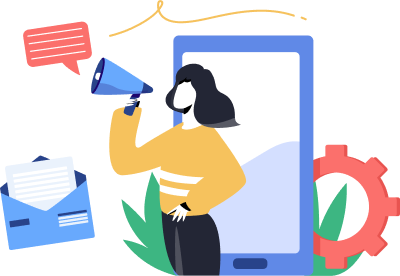Why Turn Form Submissions into Landing Pages? Many companies receive form submissions that contain valuable content rather than just lead..

The Symphony of Sentiment: Taming Tone in B2B Software Marketing
As a content marketer, you're an artist. You don't wield a paintbrush or chisel a marble block. Instead, your palette is filled with words, phrases, and sentences, your canvas the screen of a potential customer. What's the masterpiece you're creating? It's not a landscape or a portrait; it's a persuasive and captivating narrative that entices prospects to consider your B2B software solution.
The tones and sentiments you use in your marketing communications are like the color schemes and brush strokes you would use in a painting. They set the mood, create a setting, and provide depth and dimension to your narrative. They're also potent tools that can influence your prospect's decision-making process, adding a unique blend of neurolinguistic magic to your marketing mix.
A key to mastering more productive communications is a science called neurolinguistic programming.
What is Neurolinguistic Programming?
Neurolinguistic programming (NLP) is an approach to communication, personal development, and psychotherapy created by Richard Bandler and John Grinder in California, United States, in the 1970s.
NLP has been adopted by some hypnotherapists and by companies that run seminars marketed as leadership training to businesses and government agencies. It is also used as a method for personal development, often by coaches and individual practitioners.
Key Components of NLP include:
- Modeling: This is the process of adopting the behaviors, language, strategies, and beliefs of another person. The aim is to 'model' someone who is successful in a specific area to achieve similar results
- Subjective Experience: NLP proposes that people experience the world subjectively and that this subjective representation of experience affects behavior.
- Presuppositions: These are beliefs that guide the NLP process. For example, one presupposition is that the 'map is not the territory.' This means that individual people do not respond to reality directly, but rather to their own perception of reality.
- Eye Accessing Cues The belief that direction in which a person looks can indicate whether they are remembering or constructing an image or experience.
- Meta-modeling A technique used in NLP that identifies distorted, deleted, or generalized information in a speaker's language.
Despite these components, it's important to note that NLP is controversial and widely regarded as pseudoscientific by psychologists and researchers. Critics argue that NLP is not supported by empirical evidence, and its underlying theories are not consistent with established knowledge in neuroscience and linguistics.
What is the Value of Neurolinguistic Programming for B2B Marketers?
Despite these criticisms, NLP can be applied in a B2B marketing context in several ways:
- Building rapport with clients: Using NLP techniques, marketers can build strong relationships with clients by mirroring their language, tone, and body language.
- Enhancing communication skills: By understanding how people process and interpret information, marketers can tailor their messages more effectively.
- Understanding customer needs and motivations: NLP techniques can help marketers understand the underlying needs and motivations of their customers, enabling them to tailor their product offerings and marketing messages accordingly.
- Sales techniques: NLP can be used to improve sales techniques, for example by using language patterns that can influence a potential buyer's decision-making process.
Again, it's important to approach these potential applications with skepticism, given the lack of empirical support for NLP.
Scroll to the bottom for a list of resources related to Neurolinguistic Programming.

A Symphony of Sentiment
Let's talk about sentiment first. In neurolinguistics, sentiment refers to the emotion or attitude expressed in the language we use. It's not just what you say, but how you say it. Every word, phrase, or sentence you use in your content can evoke specific emotions in your reader, whether positive, negative, or neutral.
In the context of B2B software marketing, the power of sentiment cannot be understated. It's the secret ingredient that can transform a mundane product description into an engaging story. A software solution isn't just a tool; it's a trusted companion that's going to save your prospect's team countless hours, boost productivity, and make their lives easier.

Setting the Tone
Tone, on the other hand, is like the musical score underpinning a movie scene. It sets the atmosphere and amplifies the sentiment. A lighthearted, casual tone might make your software solution seem accessible and user-friendly. A more serious and formal tone can convey reliability and professionalism.
But here's the kicker: your tone should not be set in stone. It needs to be flexible, adaptable, and, most importantly, receptive to your prospect's needs and context. This leads us to a crucial point. You need to see them for who they are and talk accordingly.

Dance to Your Prospect's Tune
In the world of content marketing, there's a common pitfall: falling in love with your own voice. While having a distinctive brand voice is important, it should not be at the expense of connecting with your prospect. The golden rule here? Write for your reader, not for your brand.
Think of your prospect as a partner in a dance. You need to match their rhythm, mirror their moves, and anticipate their next step. Similarly, your content should resonate with their needs, challenges, and desires. It should speak their language, not your brand's corporate jargon.

More Than Just a Sales Pitch
Remember, your B2B software solution isn't just a product; it's a solution to your prospect's problem. Your content should not be a sales pitch; it should be a supportive conversation. It's like saying, "Hey, I see you're struggling with this issue. Here's how our solution can help."
By using a tone and sentiment that reflect empathy and understanding, you're not just selling a product. You're building a relationship. You're showing your prospects that you're not just a vendor, but a partner who's genuinely invested in their success.
Your Brand Voice Doesn’t Matter
We hear revenue leaders talk a lot about the power of their brand. Sometimes their brand voice really resonates with their buyer, but what we find is that happens usually because they got lucky. Their audience mostly likes to be spoken to in the same way their brand shows up in content, copy, ads, etc.
There are two ways to approach the brand voice opportunity (note that we deeply believe in the power of branding in B2B!):
- Survey your buyers’ voice and personalities: There are tools like crystalknows.com that offer insights into the personality profiles of your buyers including how to influence them. Start there!
- Look at what is working in your marketing. Change the voice. Play with tone. See what drives the most social post engagement and email responses and build from there. Be as thoughtful about testing tone as you are about subject lines and button colors on landing pages.
In Conclusion
In the grand orchestra of content marketing, tone and sentiment are your lead instruments. They set the tempo and harmonize the melody, creating a symphony that resonates with your prospects. In the realm of B2B software marketing, they transform your content from a simple sales pitch into a captivating narrative, a supportive conversation, and a memorable experience.
So, remember to be flexible with your tone, be empathetic in your sentiment, and don't shy away from being a little witty. Because at the end of the day, your content is not just about your software solution. It's about your prospect, their needs, and how you can help them succeed. And that, dear reader, is the art and science of content marketing.
So next time you pick up your 'brush' and 'palette' (or keyboard and thesaurus), remember to tune in to your prospect's wavelength. Let's make the B2B world a little less gray, a little less jargon-filled, and a whole lot more empathetic and engaging. Here's to creating masterpieces that don't just sell products, but build relationships and change lives.
As the maestro of your brand's marketing symphony, it's your responsibility to ensure that every note strikes a chord with your audience. So let your content sing, let it resonate, and let it make beautiful music that leaves a lasting impression on your prospects. Remember, it's not about speaking the loudest, but about making your voice matter. Happy composing!
Neurolinguistic Programming Resources
Here are some top websites and blogs related to Neurolinguistic Programming (NLP):
- Global NLP Training Blog: https://www.globalnlptraining.com/
- ANLP Blog: https://anlp.org/blog
- NLP Coaching Blog: https://www.nlpcoaching.com/blog
- NLP Sure: https://www.nlpsure.com/
- Excellence Assured: https://www.excellenceassured.com/
- Inspire 360: https://www.inspire360.co.uk/
- NLP Explained: https://www.nlp-explained.com/
- NLP School Blog: https://www.nlpschool.com/blog
- NLP Training World: https://www.nlptrainingworld.com/
- The NLP Center of New York: https://www.nlptraining.com/blog
- Transform Destiny: https://www.transformdestiny.com/
- Steve Andreas' NLP Blog: https://www.realpeoplepress.com/
- NLP Coaching Academy: https://www.nlpcoach.in/blog
- NLP is Fun: https://www.nlpisfun.com/
- PCI Institut: https://www.pci-institut.net/

Subscribe to the
Air Trafic Control newsletter
Receive regular tips and resources to boost your establishment!
Related Blogs
We have something for everyone on our blog. Dig in!
In today's digital-first B2B landscape, understanding buyer intent has become more crucial—and more complex—than ever. As buying committees..
Personalization is no longer optional – it’s expected. Tailoring your website’s content to the specific needs and interests of each visitor..
